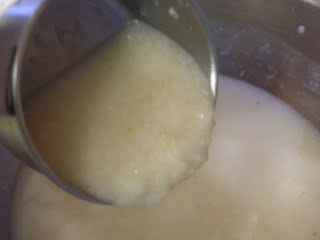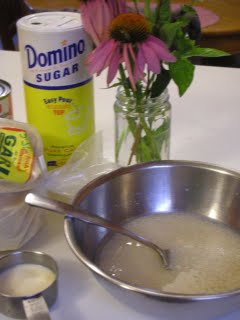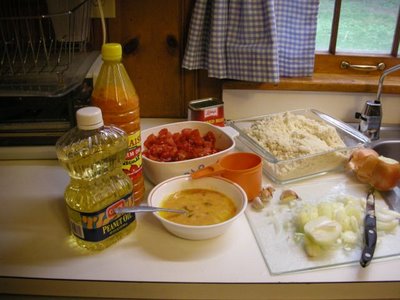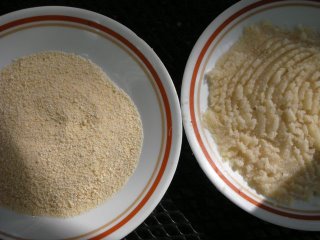Recipe #16: Gari potowye (soaking)
Yesterday I featured a recipe for iced kenkey. Today I'd like to share another snack/porridge- type food I learned to call "gari soak" or "gari soaking." My sister-in-law, Theodora, was unfamiliar with those terms, but knows it by its Fante name "gari-potowye."
It's also simple to make. Take a small amount of gari (I've only used the finely sifted Ghanaian version, not the coarser Nigerian one, but it would work, too). For Americans, I imagine 1/4 - 1/3 cup makes a serving, though for Ghanaians it might take twice that much. Remember that gari swells up to almost 3 times its size when liquid is added to it.
Traditionally people pour the gari into a bowl and fill the bowl with water a couple of times to clean the gari and allow them to pour off any impurities that float to the top.
Like iced kenkey, Theodora agrees gari-potowye "is cheap and easy to make. . . people eat (it) mainly to quench thirst/hunger until they can make or eat something more filling. . ."
To make "gari- potowye," after rinsing the gari and pouring off any chaff/impurities and most of the extra water, one adds cold or iced water, remembering to add enough to keep it from becoming too thick. For 1/4 cup, after draining off most of the water used to rinse the gari, use 1/4-1/2 cup cold (ice) water. If you are adding milk, you may stay with the lower amount of water. You can always add more milk or water if after it sits for a few minutes you think the mixture is too thick. Conversely, if you add more liquid than you like, you can always sprinkle in a little more gari. As I've said before, Ghanaian cooking is very flexible and forgiving.
Theodora likes her gari potowye best after refrigerating it for about 30 minutes (i.e., it will be softer). As with the iced kenkey, one may add roasted peanuts (in Ghana these would likely be dry roasted and unsalted), milk (evaporated, powdered or fresh) and sugar to taste.
I found an online site in the U.K. that sells processed gari "Kwik meal gari soaking" to make this dish. Their Kwik brand included cocoa in the mix, something I've never heard of before in Ghana (nor had Julia or Theodora).
Julia affirms, "Yes, it's (gari soaking) delicious with roasted nuts, usually not crushed. It is also not described (as) a drink, though some people may dunk it, but rather (is) watery and eaten with a spoon since the gari thickens if you don't have enough water. The milk tends to slow this down."
Gari soaking has a milder taste than iced kenkey. It can be prepared more or less thick, crisper
 or soggier, according to taste. As Holli, a Canadian living in Ghana for over a dozen years noted in a comment on yesterday's posting "There is. . . (a) food . . .that my kids love, . . . made with dried gari (cassava powder). Pour the dried gari into water, add evaporated milk (Ideal Brand here!), peanuts and sugar... it has a similar flavour to breakfast cereal!"
or soggier, according to taste. As Holli, a Canadian living in Ghana for over a dozen years noted in a comment on yesterday's posting "There is. . . (a) food . . .that my kids love, . . . made with dried gari (cassava powder). Pour the dried gari into water, add evaporated milk (Ideal Brand here!), peanuts and sugar... it has a similar flavour to breakfast cereal!"Gari prepared this way is another student and boarding school staple. I think of this cassava meal as Ghana's favorite convenience food, and "gari soaking" is another example. In the coming months I'll feature gari regularly, in ways both savory and sweet.
By the way, the images I'm posting these days were generally meant to be functional, not carefully composed food photography. I leave my camera in the kitchen and take utilitarian photos so you can see what I'm describing. Our cookbook will be visually much more exciting! Also, today I was fresh out of peanuts, so they're missing from the picture, though the added crunch they give to gari soaking is wonderful. For those with allergies, try another type of nut.
Labels: cassava, gari, gari potowye, gari soaking, ghana snacks, Julia Yeboah, manioc, Theodora Osseo-Asare





